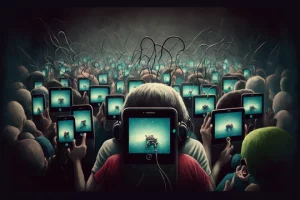By Sachin Kapoor
 In 2017, Frontiers in Psychiatry published ‘An Update Overview on Brain Imaging Studies of Internet Gaming Disorder’ as part of their research on IGD or Internet Gaming Disorder.
In 2017, Frontiers in Psychiatry published ‘An Update Overview on Brain Imaging Studies of Internet Gaming Disorder’ as part of their research on IGD or Internet Gaming Disorder.
The conclusion was startling:
“There is emerging evidence that IGD is associated with similar brain mechanisms responsible for substance use disorders. The brain imaging studies in IGD show similarity in brain mechanisms between IGD and substance use disorder and therefore support the classification of IGD as a behavioral addiction.”
In simple words,
— Screen addiction is an addiction classified as per WHO
 — Its impact on the brain is similar to substance (e.g. Narcotics like Cocaine) use addiction
— Its impact on the brain is similar to substance (e.g. Narcotics like Cocaine) use addiction
In short, there may be an irreversible long term impact on the brains of children addicted to Internet games. However the question arises if only internet games are to be blamed or the problem is broader. In 2019, researchers made an attempt to bring together all the use cases under the umbrella of SmUD (Smartphone Use Disorder).
It was the research of Joel Billieux who provided clear pathways into problematic mobile phone usage. He emphasised on the following four pathways for SmUD:
— Impulsive
— Relationship
— Extraversion
— Cyber Addiction
Billieux further broke down cyber addiction into online gambling, online video games, online sex, social networks and mobile phone, thereby defining a spectrum of cyber addictions
Fig 1: Spectrum of cyber addictions
Many parents despair at the amount of time their kids spend glued to screens, as a recent study by Kantar for Amazon India showed. However, they may not be in a position to co-relate symptoms in a child’s behaviour with cyber or mobile addiction.
Research published by the National library of medicine suggests that both physical and mental wellbeing can be adversely affected by too much screen use. It divides students into low cell phone usage and high Cell Phone usage groups and came up with the following conclusions.
— Physical: High Cell Phone usage group observed higher numbers of eye strain, neck pain, back pain, and gain in weight
— Mental: High Cell Phone usage group were more likely to report loneliness, depression, and mood disorders
In short, excessive phone usage is going to do you and your children harm. And what you may be passing off as a lifestyle aberration, may be the symptom of a larger disorder taking shape for e.g. eye strain and lack of concentration may be the trigger point for ADHD (attention deficit hyperactivity disorder) aggravated by years of mobile phone usage.
At this point, it is important for us to introduce neurotransmitters, especially dopamine commonly called the happiness hormone. But sudden surges in dopamine release causes addiction, this is exactly what cocaine or narcotics do inside our body. They release a lot of dopamine, the brain responds less to the excess dopamine. Then we consume more to release more dopamine. Eventually this cycle leads to mania, hallucinations and delusions. Now, here is the fun fact: the reason you can’t put that mobile phone down is because it releases cheap and plentiful dopamine in your brain. So you are on a high without consuming anything, just by spending more and more time on a mobile screen on gaming, gambling, sex or social networks!
A logical question therefore is how many hours a day is classified as addiction. A few researchers came up with a limit of 20 hours a week. But, this is hotly contested and WHO has refrained from providing hour-based classification of mobile addiction. Among practitioners a generally held view is that the behaviour of the addict should be such that spending time on the phone comes at the expense of normal life commitments. An often cited example is that you have an exam or an assignment submission but you skip it because you were unable to keep your mobile phone away.
You may start wondering if this is such an important problem, considering that 70 per cent of India’s population has smartphones. What is being done to solve the problem? To begin with, is it being identified as a problem? The bugle was sounded by Prime Minister Narendra Modi in his Pariksha Pe Charcha wherein he highlighted the distractions mobile phones may cause to students preparing for exams.
There is a lot that needs to be done by different stakeholders like Educators, Health Practitioners, Mobile Device Manufacturers, Mobile Gaming Companies.
However, the biggest question to ask is for a parent themselves. When you hand over a phone or a mobile device to a young child, are you aware you may be starting a one-way cycle for impairing the potential of your own child? What do you think you can do as a parent to change course midway? If you are just starting out, what may be your alternatives to entertain your newborn beyond the mobile screen? To all parents, the question is “are you making your child addicted to cocaine”? (IANs)
(The author is co-founder of ‘Trumsy’, an initiative to reduce screen time of children)



